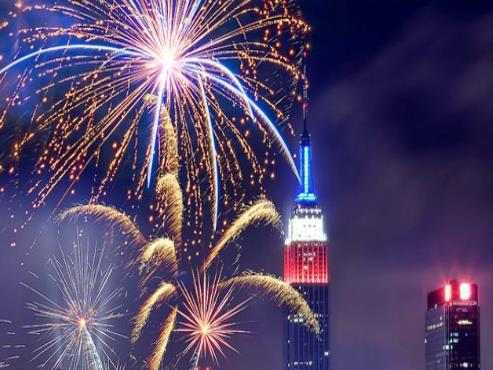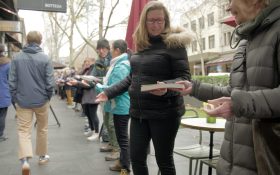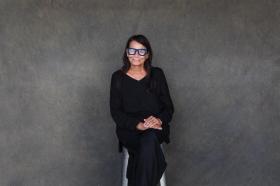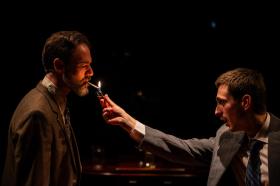Blockbuster exhibitions are presented in the media as offering a unique perspective on events spruiked as ‘never to be seen again’. Each blockbuster is presented as the ‘first’ and ‘only’ of its kind, creating an impression of exclusivity to audiences, urgency and ‘must see’.
Last Saturday night on the Sydney Harbour really was a first as the most unlikely organisation – the Royal Australian Navy – joined the chorus of blockbuster hype that usually belongs in museum and gallery settings.
Examining the Navy spectacular is a good opportunity to consider what makes a blockbuster and translate the insights into the arts sector. Blockbusters are large-scale, high-risk, investment dependent, widely-promoted, which achieve massive audience support by links to fame and celebrity. All these factors were present in the Navy spectacular on Sydney Harbour. It was big. It was spectacular. It rang true. It was full of colour. It appealed to a broad audience, not just those who love the military.
Key to this blockbuster was the use of an international celebrity, Prince Harry, to help promote the event. Media described him as ‘the people’s prince’, drawing making comparisons to his late mother, Diana, Princess of Wales. Young women were swooning; even the Prime Minister’s daughters were ‘pinching themselves’. Celebrities attract audiences from a wide range of backgrounds to blockbusters, especially people who do not usually attend lower-profile events. In most cases, media coverage of blockbuster exhibitions resemble the approach used in tabloid magazines read by the general public rather than high art journals for the cogniscenti. For example, Qantas Magazine described Napoleon and Josephine in the Napoleon: Revolution to Empire exhibition as ‘glamorous’, a ‘power couple…long before Hollywood and the tabloids coarsened the term. Napoleon and Josephine are made to appear like celebrities; they are like Prince Harry. Similarly in covering Picasso, the Sydney Morning Herald focused on the artist’s private life, which it noted ‘has the power to fascinate: the famous friends, the illegitimate children, the family feuds and of course, the women’, Whether it is the Navy or an art exhibition, celebrity works for blockbusters.
Celebrities can be used to created linkages with other events and celebrities. Prince Harry wass compared not only to his late mother, but to his brother Prince William in the Herald Sun, seeking to link the popularity of one brother to the other. Grace Kelly’s connections with Alfred Hitchcock, the director of many of her Hollywood films, was used in promoting the exhibition of her clothes at the Bendigo Art Gallery. Citing Hitchcock’s autobiography, the writer referred to ‘the subtlety of Grace’s sexuality—her elegant sexiness’.”
Sex and celebrity are of course a valuable combined sell for blockbusters. Princess Grace’s profile for the new generation was boosted by references to Princess Charlene, the newly minted princess of Monaco who married Prince Albert, as well as the British Duchess of Cambridge in her fashion sense for her bridal dress. Crowds lined the streets to see this blockbuster, imagining themselves in the fairy tale story.
Smaller exhibitions also use these techniques of course. The fashion theme has been picked up by the Immigration Museum in Melbourne, which has an exhibition on the hijab, and the ABC/National Trust now displaying the clothes from Miss Fisher’s Murder Mysteries at Rippon Lea. These linkages provide further legitimacy to the fairy-tale story told via blockbusters.
Blockbusters mostly present positive stories in a media replete with negativity. The public laps it up. How curious that the Navy is telling its own fairy tale story via a blockbuster, with women foregrounded on the images super-imposed on the sails of the Opera House and men in uniform blowing drumming and bugling and causing women to swoon.
Images always support the use of the blockbuster narrative. Pictures of Princess Grace and Princess Charlene to reinforce the image of a “real life [fairy-tale]” reported in the media. Pictures of Prince Harry provide a narrative for the Navy about handsome men in leadership roles doing brave things in uniform. Grace Kelly became the ‘cover girl’ for her blockbuster, with the focus on her style, discrete sexiness and celebrity just as Prince Harry was the ‘cover boy’ of the Navy blockbuster.
Images in blockbusters are always counterpointed by touches of red, which attract the eye of the viewer. Grace Kelly had touches of red on her clothes in promotion material. The Navy blockbuster had seas of red, for obvious reasons, when illustrating the brave soldiers who fought in WWII. The closest we get to death and destruction is via the use of red imagery in the light show.
But uniforms by themselves on a mannequin do not sell a blockbuster; the celebrity story line does. In this way, interest is boosted across domains from royalty to Hollywood, sex appeal to celebrity, touching a variety of potential audiences.
In this way audiences are broadened, appeal is widened and popularity -whether of art or of a Navy career – is increased.
Image: Fireworks at the Navy Spectacular





